
Hieronymus Bosch was a Dutch painter from Brabant. He is one of the most notable representatives of the Early Netherlandish painting school. His work, generally oil on oak wood, mainly contains fantastic illustrations of religious concepts and narratives. Within his lifetime his work was collected in the Netherlands, Austria, and Spain, and widely copied, especially his macabre and nightmarish depictions of hell.

Luis de Morales was a Spanish painter active during the Spanish Renaissance in the 16th century. Known as "El Divino", most of his work was of religious subjects, including many representations of the Madonna and Child and the Passion.
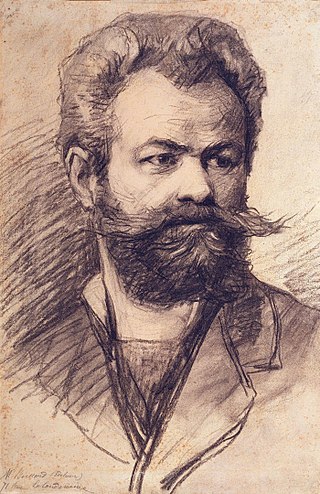
Mihály Munkácsy was a Hungarian painter. He earned international reputation with his genre pictures and large-scale biblical paintings.

Ecce homo are the Latin words used by Pontius Pilate in the Vulgate translation of the Gospel of John, when he presents a scourged Jesus, bound and crowned with thorns, to a hostile crowd shortly before his Crucifixion. The original New Testament Greek: "ἰδοὺ ὁ ἄνθρωπος", romanized: "idoù ho ánthropos", is rendered by most English Bible translations, e.g. the Douay-Rheims Bible and the King James Version, as "behold the man". The scene has been widely depicted in Christian art.
"Ecce homo", is a phrase traditionally attributed to Pontius Pilate at the trial of Jesus.

Ecce Homo is a painting by the Italian Baroque master Caravaggio. It is housed in the Palazzo Bianco, Genoa. Contemporary accounts claim the piece was part of a unannounced competition between three artists, and that the Caravaggio version was eventually sent to Spain.
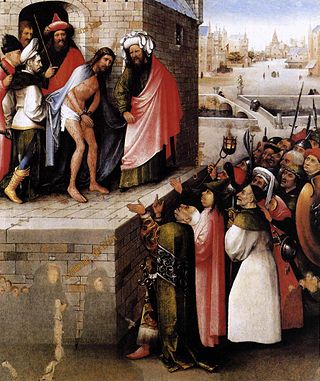
Ecce Homo is a painting of the episode in the Passion of Jesus by the Early Netherlandish painter Hieronymus Bosch, painted between 1475 and 1485. The original version, with a provenance in collections in Ghent, is in the Städel Museum in Frankfurt; a copy is held the Museum of Fine Arts in Boston. The painting takes its title from the Latin words Ecce Homo, "Behold the Man" spoken by the Roman Prefect Pontius Pilate when Jesus is paraded before a baying, angry mob in Jerusalem before he is sentenced to be crucified.

Christ Carrying the Cross is a painting attributed to a follower of Hieronymus Bosch. It was painted in the early 16th century, presumably between 1510 and 1535. The work is housed in the Museum of Fine Arts in Ghent, Belgium. The painting is notable for its use of caricature to provide grotesque-looking faces surrounding Jesus.

Christ Crowned with Thorns, sometimes known as Christ Mocked, is an oil on panel painting by Hieronymus Bosch. It is held in the National Gallery in London, which dates it to around 1510, though some art historians prefer earlier dates.

John Graver Johnson was an American corporate lawyer and art collector. The Philadelphia law firm that he founded in 1863 continues under the name Saul Ewing. His collection of nearly 1,300 paintings forms the core of early European works at the Philadelphia Museum of Art.
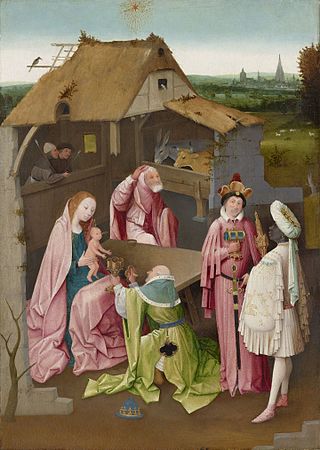
The Adoration of the Magi is an oil painting on wood panel attributed to the workshop of Netherlandish artist Hieronymus Bosch, executed around 1499. It is housed in the Philadelphia Museum of Art, USA. The museum's catalog assign it to around 1518, as having been finished by Bosch's workshop. According to Dendochronologic research, it could have been painted in 1493–1499.

The Adoration of the Magi is an oil painting on wood panel by Netherlandish artist Hieronymus Bosch, executed around 1475. It is housed in the Metropolitan Museum, New York, US. A prominent feature of this painting is the strong perspective effect and also the copious use of gold leaf, which is not very typical for Bosch. The pigments employed are red lake, azurite, lead-tin-yellow and ochres.
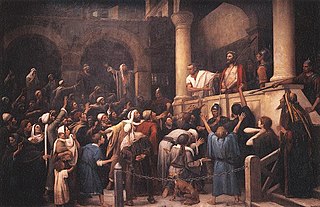
Ecce Homo is a statue of Jesus during his trial after being imprisoned by the Romans. The statue's title, Ecce Homo, is an allusion to the famous proclamation by Pontius Pilate, "behold the Man." The statue, made entirely of carved wood, depicts Jesus in a horrific state of suffering and anguish. Although its creator remains anonymous, Ecce Homo is believed to have been carved in Spain sometime around the year 1600 AD.
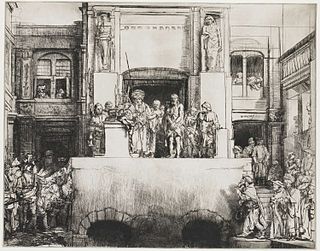
Christ Presented to the People, also known as Ostentatio Christi or Ecce Homo, is a drypoint print by Rembrandt van Rijn which exists in eight states, all c.1655. It is one of the two largest prints made by Rembrandt, about 15 by 18 inches, similar to his 1653 engraving of The Three Crosses. It has been described by Christie's as "at the summit of the western printmaking tradition".

Christ Presented to the People is a mid 16th century painting by Giovanni Antonio Bazzi, an Italian artist commonly known as Il Sodoma. Done in oil on canvas, the work depicts the biblical scene in which Jesus Christ is presented to the people by Pontius Pilate with the phrase "Ecce homo". The painting is in the collection of the Metropolitan Museum of Art.
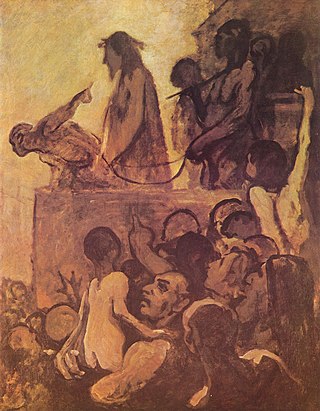
Ecce Homo is an unfinished oil-on-canvas painting by the French painter and caricaturist Honoré Daumier, created in 1850. It is in the collection of the Museum Folkwang in Essen, Germany.
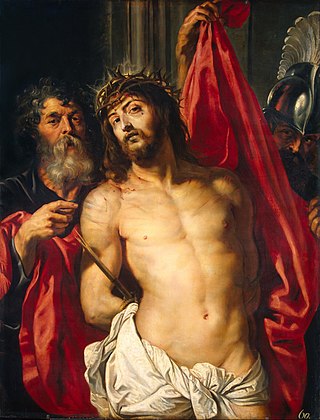
Ecce Homo or Christ Wearing the Crown of Thorns is an oil on oak panel painting of the Ecce Homo subject by Peter Paul Rubens, executed c. 1612, now in the Hermitage Museum, in Saint Petersburg. The Hermitage also houses an oil study for its figure of Pilate.
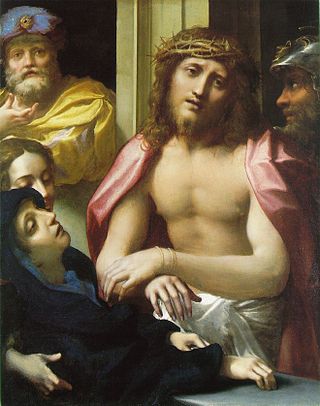
Ecce Homo, also known as Christ Presented to the People, is an oil painting by Antonio da Correggio. It is the last of the surviving pictures of the Passion of Jesus that Correggio executed during the 1520s. The painting is in the National Gallery, London.

The Ecce Homo is a large oil painting by Titian, signed and dated 1543, which hangs in the Kunsthistorisches Museum in Vienna. It is not to be confused with several smaller compositions by Titian.


















